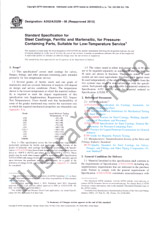Potřebujeme váš souhlas k využití jednotlivých dat, aby se vám mimo jiné mohly ukazovat informace týkající se vašich zájmů. Souhlas udělíte kliknutím na tlačítko „OK“.
ASTM D5083-17
Standard Test Method for Tensile Properties of Reinforced Thermosetting Plastics Using Straight-Sided Specimens
Přeložit název
NORMA vydána dne 15.3.2017
Informace o normě:
Označení normy: ASTM D5083-17
Datum vydání normy: 15.3.2017
Kód zboží: NS-678486
Počet stran: 8
Přibližná hmotnost: 24 g (0.05 liber)
Země: Americká technická norma
Kategorie: Technické normy ASTM
Kategorie - podobné normy:
Anotace textu normy ASTM D5083-17 :
Keywords:
ICS Number Code 83.140.20 (Laminated sheets)
Doplňující informace
| Significance and Use | ||||||||||||||||||||||||||
|
4.1 This test method is intended for tensile testing of fiber-reinforced thermosetting laminates. For injection molded thermoplastics, both reinforced and unreinforced, Test Method D638 is recommended. For most unidirectional fiber reinforced laminates, Test Methods D3039/D3039M is preferred. 4.2 This test method is designed to produce tensile property data for quality control and research and development. Report all factors that influence the tensile properties, such as: material, methods of material and specimen preparation, specimen conditioning, test environment, speed of testing, void content, and volume percent reinforcement. See Section 12 for reporting requirements. 4.3 It is realized that a material cannot be tested without also specifying the method of preparation of that material. Hence, when comparative tests of materials per se are desired, the greatest care must be exercised to ensure that all samples are prepared in exactly the same way, unless the test is to include the effects of sample preparation. Similarly, for referee purposes or comparisons within any given series of specimen, care must be taken to secure the maximum degree of uniformity in details of preparation, treatment, and handling. Note 6: Preparation techniques for reinforced thermosetting
plastics can be found in the part of ISO 1268 appropriate to the
manufacturing technique for the laminate.
4.4 Because of the high degree of sensitivity exhibited by many reinforced plastics to rate of straining and environmental conditions, data obtained by this test method cannot be considered valid for applications involving load-time scales or environments widely different from those of this test method. In cases of such dissimilarity, no reliable estimation of the limit of usefulness can be made for most plastics. This sensitivity to rate of straining and environment necessitates testing over a broad load-time scale (including impact and creep) and range of environmental conditions. Note 7: Since the existence of a true elastic limit in
plastics (as in many other organic materials and in many metals) is
debatable, the propriety of applying the term “elastic modulus” in
its quoted generally accepted definition to describe the
“stiffness” or stress-strain characteristics of plastic materials
is highly dependent on such factors as rate of application of
stress, temperature, previous history of specimen, etc. However,
stress-strain curves for plastics, determined as described in this
test method, almost always show a linear region at low stresses. A
straight line drawn tangent to this portion of the curve permits
calculation of an elastic modulus of the usually defined type. Such
a constant is useful if its arbitrary nature and dependence on
time, temperature, and similar factors are realized.
4.5 For some materials, there are specifications that require the use of this test method, but with some procedural modifications that take precedence when adhering to the specification. Therefore, it is advisable to refer to that material specification before using this test method. Table 1 of Classification D4000 lists the ASTM materials standards that currently exist. |
||||||||||||||||||||||||||
| 1. Scope | ||||||||||||||||||||||||||
|
1.1 This test method covers the determination of the tensile properties of thermosetting reinforced plastics using test specimens of uniform nominal width when tested under defined conditions of pretreatment, temperature, humidity, and testing-machine speed. Note 1: Experience with this test method to date has been
limited to glass-reinforced thermosets. Applicability to other
materials remains to be determined.
1.2 This test method is used for testing materials of any thickness up to 14 mm (0.55 in.). Note 2: This test method is not intended to cover precise
physical procedures. It is recognized that the
constant-rate-of-crosshead-movement type of test leaves much to be
desired from a theoretical standpoint, that wide differences may
exist between rate-of-crosshead movement and rate of strain between
gauge marks on the specimen, and that the testing speeds specified
disguise important effects characteristic of materials in the
plastic state. Further, it is realized that variations in the
thicknesses of test specimens that are permitted by these
procedures, produce variations in the surface-volume ratios of such
specimens, and that these variations may influence the test
results. Hence, where directly comparable results are desired, all
samples should be of equal thickness. Special additional tests
should be used where more precise physical data are
needed.
Note 3: Use of this test method for testing materials of
thicknesses greater than 14 mm (0.55 in.) is not recommended.
Reducing the thickness by machining may be acceptable for materials
of uniform reinforcement amount and direction, but is generally not
recommended.
1.3 Test data obtained by this test method is relevant and appropriate for use in engineering design. 1.4 The values stated in SI units are to be regarded as standard. The inch-pound units given in parentheses are for information only. 1.5 This standard does not purport to address all of the safety concerns, if any, associated with its use. It is the responsibility of the user of this standard to establish appropriate safety and health practices and determine the applicability of regulatory limitations prior to use. Note 4: This standard and ISO 527-4 address the same subject
matter, but differ in technical content.
(a) This test method does not include testing of the Type I dogbone shaped specimen described in ISO 527-4. Testing of this type of specimen, primarily used for reinforced and un-reinforced thermoplastic materials, is described in Test Method D638. (b) The thickness of test specimens in this test method includes the 2 mm to 10 mm thickness range of ISO 527-4, but expands the allowable test thickness to 14 mm. (c) ISO 527-4 allows for the use of holes in the tabs of the test specimen while this standard does not. (d) The definitions for tensile strength and modulus differ between these two standards. Note 5: For tensile properties of resin-matrix composites
reinforced with oriented continuous or discontinuous high modulus
> 20-GPa (> 3.0 × 106 -psi) fibers, tests shall be
made in accordance with Test Method D3039/D3039M or ISO 527 Part
5.
|
||||||||||||||||||||||||||
| 2. Referenced Documents | ||||||||||||||||||||||||||
|
Doporučujeme:
Aktualizace technických norem
Chcete mít jistotu, že používáte pouze platné technické normy?
Nabízíme Vám řešení, které Vám zajistí měsíční přehled o aktuálnosti norem, které používáte.
Chcete vědět více informací? Podívejte se na tuto stránku.




 Cookies
Cookies
